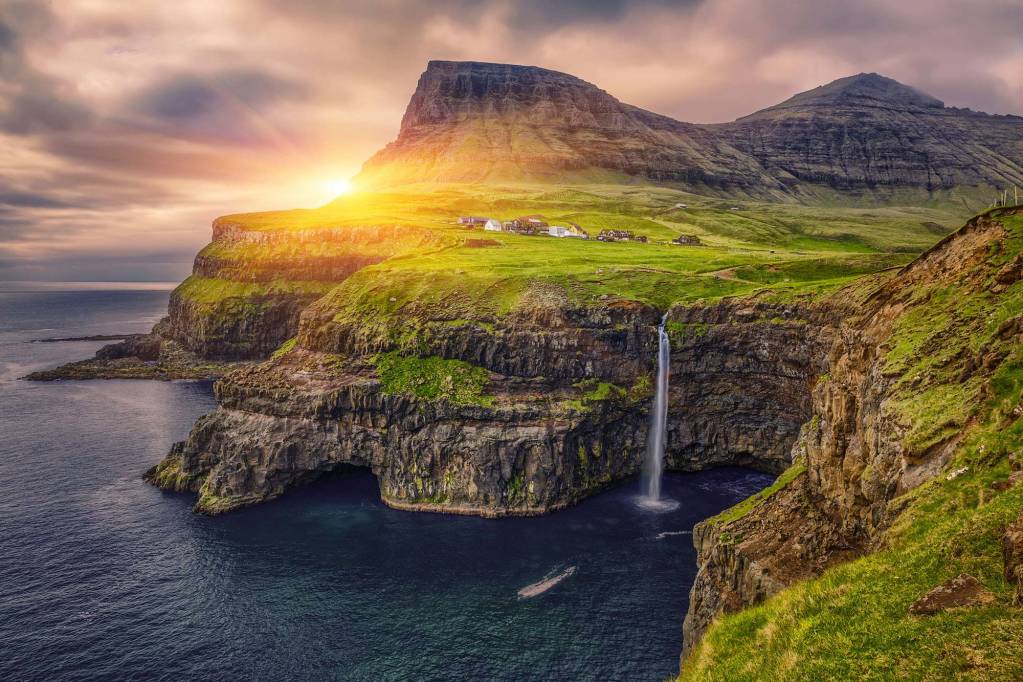The Faroe Islands represent an archipelago of 18 islands in the North Atlantic Ocean, approximately 600 kilometres off the coast of Scotland, nestled between both Iceland and Norway and southwest of the Norwegian archipelago Svalbard.

The landscape of the Faroe Islands is a stunning mix of waterfalls, towering cliffs, rolling green hilltops, volcanic bedrock, vast river beds
and deep fjords . Photo: AdobeStock
The islands are made up of volcanic bedrock and much of the archipelago is elevated well above sea level. Scenic cliffside views, beautiful fjords, and vast river beds constitute much of the terrain across the Faroe Islands.
In addition to the natural wonders of the islands, there’s an impressive array of wildlife that inhabits the Faroe Islands. Many people choose to venture to the Faroe Islands for the specific purpose of bird watching, to glimpse some of the species that are native to the Faroe Islands. For people who love adventures in isolated pockets of the world shrouded in beauty, intrigue, and mystery, the Faroe Islands should rank right near the top of the list of your dream destinations. In this article, we will look at the best time to visit the Faroe Islands, among other interesting facts.
What and where are the Faroe Islands?
The Faroe Islands archipelago lies about 650 kilometres off the coast of Western Europe. They were long believed to have been discovered during the Viking era when Norse explorers traveled due west in search of new lands to conquer. The Faroe Islands were one of the first locations visited by Vikings during their time of exploration.
However, that claim has recently been challenged by new evidence unearthed on the islands. According to these recent findings, the Faroe Islands were first visited by either British or Irish explorers who traveled north beyond Scotland and encountered the archipelago on their journey. This remains to be confirmed, but it wouldn’t be beyond the realm of possibility since the British Isles are geographically closest to the Faroe Islands.
How do you get to the Faroe Islands?

Mykines, the westernmost of the 18 Faroe islands, has a population of approximately 170 people, who share the
rolling green hills and cliffsides with thousands of puffins. . Photo: AdobeStock
Since the Faroe Islands are an archipelago, the only means to reach the islands are either by air or by sea. Regularly scheduled flights do reach the islands, typically from Scotland, Norway, or Iceland. You can arrive on the islands from any of these destinations within one to two hours.
But flying by air to the islands means you’ll miss out on all of the amazing seafaring experiences that surround the archipelago. The powerful waves of the Atlantic Ocean are punctuated by the sights and sounds of mammals that swim through the water in plain view for curious adventurers to view from their vessels. The Faroe Islands are also just south of the Arctic Circle, which means you can witness the transition in the ocean currents from warmer to colder climates.
That’s why we recommend Quark Expeditions’ Arctic Saga: Exploring Spitsbergen via the Faroes and Jan Mayen adventure. This 14-day expedition will take you as far north as the island chain of Svalbard, and you’ll make a two-day stop at the Faroe Islands en route to the end destination.
Interesting things to do in the Faroe Islands

Bird-watchers are among the groups who are lured to the Faroe Islands. Photo: AdobeStock
While you’re on the Faroe Islands, you’ll have an opportunity to experience the medieval history that remains a hallmark of life in the archipelago. Magnificent ocean views and thriving seabird colonies are just some of the experiences that await visitors on the islands.
The Faroe Islands are very popular among explorers who love to witness animals in the wild. Bird watching, in particular, is very popular on the islands, especially the westernmost island of Mykines Island.
It’s here that bird watchers get to see the infamous Atlantic puffin, which is a rare type of bird renowned for being a creature of habit. Unlike many other types of birds, puffins will often return to the same burrows each year, and they maintain long-term connections with their mates. Your Quark Expeditions guide will help pinpoint locations where puffins are most likely to establish their burrows and help you find a vantage point where you can photograph these colorful birds in their natural habitat—from a safe distance, of course. Quark Expeditions’ guides will ensure you have an incredible wildlife experience while also ensuring no wildlife are bothered.
Best time to visit the Faroe Islands
Since the Faroe Islands are located just south of the Arctic Circle, the cold weather from the north impacts the archipelago. But the winds are less intense and carry a warmer breeze during the summer months than during the winter. Summer is also the time when puffins and other animals are most likely to roam the islands rather than seek shelter in hibernation as they do in winter months.
For that reason, it’s best to arrange a visit to the Faroe Islands during the summer season. If you join an itinerary like Arctic Saga: Exploring Spitsbergen via the Faroes and Jan Mayen, you’ll arrive at the perfect time of year. Quark Expeditions arranges voyages to the Faroe Islands beginning in late August and concluding in early September, which is the prime time of the year for a voyage to this hidden gem of an archipelago.









